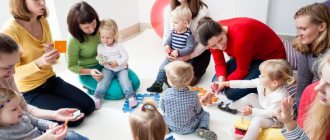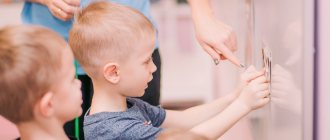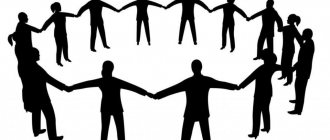Art therapy for children: exciting techniques
The state of mental health of children and adolescents today is an important task not only for parents, but also for the teaching community. A healthy child is, first of all, a creative, cheerful, open person who knows himself and the world around him. We'll tell you about several types and exciting art therapy techniques that are perfect for both young children and teenagers.
Classical art therapy initially included such types of visual art as painting, modeling, photography, and graphics. However, in the modern world, new types of creativity and self-expression are emerging. Now popular are bibliotherapy, drama therapy, dance therapy, fairy tale therapy, video and audio therapy, mask therapy, sand therapy and much more. We will focus on the most accessible and popular types of creative therapy.
Simple tips
- Don't forget that art therapy is a creative process. The main thing is to have fun, not the result.
- Let your child choose the method and materials for art therapy. As practice shows, younger children often choose sand, and schoolchildren choose gouache.
- Children should not experience difficulties during the creative process. Any efforts during the work should be interesting, original, and enjoyable for the child.
Isotherapy
The most popular type of art therapy is drawing. A wide variety of art materials are suitable for it: paints, pencils, wax crayons, pastels, paper of various textures, brushes of different sizes and hardness, plasticine, etc. There are several drawing therapy techniques.
- Marani I
are drawings made in an abstract manner that has no rules: we draw the way we want. In appearance, soiling sometimes looks like destructive actions with paints, crayons, pencils or plasticine. However, the game form of this format allows the child to satisfy destructive impulses.
- Monotype
is a basic graphic technique. On a smooth surface - glass, plastic board, film - a drawing is made with gouache paint. A sheet of paper is placed on top and pressed to the surface. The result is a mirror image print.
- Drawing on glass.
You will need a smooth glass surface and paints (a window, glass table or mirror will do). Children are fascinated by the process of drawing: the paint glides softly, it can be smeared with a brush and fingers, since it does not absorb into the glass surface and does not dry out for a long time. The described technique is used for the prevention and correction of anxiety, social fears and fears associated with the results of activities.
- Drawing with dry leaves and small bulk materials.
Using leaves, dry winds, bulk materials and PVA glue, various designs are created. An image is applied to a sheet of paper with glue. Then the material, previously crushed or ground, is scattered on top. Excess, unadhered particles are shaken off. The described technique of creating images is suitable for children with severe motor awkwardness, negativism, and tightness; it promotes the process of adaptation to a new space and gives a feeling of success.
- Drawing with fingers, palms, other parts of the body
is a kind of game with paints and new tactile sensations, during which destructive impulses and actions are expressed through prints on paper. The method is highly valued by child psychologists.
For older children, types of isotherapy such as painting with liquid acrylic or using the alcohol ink technique are suitable.
- Liquid acrylic or “Fluid Art”
is a modern type of creativity, whose main feature is that a person does not need to have any drawing skills to create a work of art. The process involves feelings such as intuition and creativity, and the technique is so simple that beginners learn it immediately. Liquid acrylic painting can be recommended to those who like to experiment, love abstract paintings, want to learn how to draw from scratch and need relaxation.
- Alcohol ink
is a technique of drawing with special ink by blowing it over a surface with a hairdryer. Creating paintings using this technique is similar to creating fancy patterns and shapes in the form of wavy geometric figures, and the play of paint is actually created by itself. All the artist needs to do is apply the dye and use his imagination.
Colored world. Allowance for children 5-6 years old.
This manual is included in the educational complex “Steps to School”, which presents a unique system for the development of school-significant functions and preparing children for school. The tasks in this manual will allow the preschooler to gain a more complete understanding of colors and their combinations, introduce them to the techniques of mixing colors, and also practice finding geometric shapes in a complex design. Complies with the Federal State Educational Standard for Preschool Education (2014). The text in the manual is intended to be read by adults to children.
Buy
Sand therapy
Who among you and I did not play in the sandbox as children?
It is useful for children to sculpt sand figures, because this is how they can develop thinking, imagination and, most importantly, fine motor skills of the fingers. In addition, in the process of working with sand, an additional emphasis is placed on tactile sensitivity. Working with sand can be used either alone or in a group if the sandbox is divided into several sections. In this way, an atmosphere of trust and integrity is achieved, and interaction in the group is established. For classes, the child will need a small sandbox, a container of water and many different molds so that the child can create a composition in the sand, describe and explain his work of art.
Dance therapy
This technique allows you to liberate the child not only physically, but also emotionally.
Here the body is a tool, and movement is a process that helps you experience, recognize and express your feelings. In modern dance therapy, there are a wide variety of dance styles. Their choice depends on the physical and emotional characteristics and preferences of the child. Dance can become a powerful therapeutic tool that can reveal, develop and correct not only the physical, but also the emotional qualities of the individual. Just turn on your favorite music and dance together! Do not offer your child specific movements; let him choose them himself.
Music therapy
Today, there are passive and active forms of music therapy. In passive music therapy, the child listens to various pieces of music that correspond to a certain psychological and emotional state.
In active music therapy, children themselves participate in the performance of musical works. They can sing in a choir, play musical instruments, using both ordinary musical instruments and unusual ones, for example, their own body (claps, tapping, etc.). A particularly effective method is joint music therapy, which not only liberates the child, but also improves interpersonal interactions between parent and child.
Collage
This model of art therapy is suitable for absolutely everyone, regardless of age. And especially for those who don’t like to draw. Creating a collage using various cut-outs and illustrations helps children express their desires and develops creativity. The child has the opportunity to understand the topic that worries him and seems important to him. Collage teaches us to understand ourselves and our desires and clearly demonstrate them.
To create a collage you will need a large sheet of paper and various illustrations, magazine clippings, photographs, labels, stickers and anything that will help you figuratively express your thoughts.
You can determine the topic in advance: your desires, goals, feelings, mood, dreams, our summer, memories of school. We have listed only some types and techniques of art therapy. You can choose the ones that suit your child based on his hobbies and interests. Do not forget that the use of art therapy can be a creative exploration for a child, as well as a way of social adaptation. Help children understand themselves and the world around them through art, imagination and play.
What are the benefits of art therapy?
The complex development of a child is built from many factors. This includes the child’s intellectual development and physical exercises (for example, choreography for children). The moral foundation and development of leadership qualities are important. But the framework for everything is the child’s harmonious mental state and self-confidence. Through creativity, a child not only achieves this internal balance, but also acquires many other useful skills:
- Knows himself, forms a concept of himself as a person, individuality;
- Safely and harmoniously experiences difficult and destructive feelings;
- Learns to express oneself;
- Develops a sense of self-worth and significance;
- Improves academic performance and socialization in a team;
- Learns to look for answers to your questions;
- Develops emotional intelligence, learns to feel your emotions and needs;
- Improves thinking speed;
- Develops fine motor skills by working with clay, plasticine, brushes, and finger paints.
Art therapy games card index (senior group) on the topic
Art therapy games
Sketch of “Huggers”
Purpose: removing muscle tension. The sketch can be used in working with anxious children.
The psychologist tells the children: “Imagine that you are hugging a huge elephant, hippo, or pig.” Children pretend to “hugg” with their arms wide apart. Then the psychologist invites the children to pet the kitten, puppy, and gently pick up the hamster. The sketch ends with hugging oneself and other children.
Sketch "Stars"
Goal: relaxation, removal of muscle tension. Can be used in correctional work with anxious and hyperactive children.
Children lie down on the carpet to relaxing music. The psychologist pronounces the therapeutic text: “Let’s close our eyes. Now I will count to five and you and I will turn into celestial stars. One, two, three, four, five - we became little stars. Let's spread our arms and legs wide apart - imagine that these are rays filled with light. We breathe evenly and deeply. Every breath fills us with lightness and light. Anxiety goes away and all problems leave us. We lie in the sky and we can see everything from above, we know everything about everything, we feel calm and at ease, we are not in a hurry. Now I will count to five, we will open our eyes and turn into boys and girls again. One, two, three, four, five, open our eyes.”
Exercise “On the seashore”
Goal: relaxation, relieving psycho-emotional stress. Children lie down on the carpet. The psychologist turns on the music “The Sound of the Sea” and says in a calm, even voice: “Close your eyes, imagine that we are lying on the seashore. The warm sun is shining, we are basking in it. Arms and legs are relaxed. Warmth spreads throughout the body. A gentle breeze is blowing (at this moment you can pet each child). Breathe calmly and deeply. We take in full lungs of air and exhale all the air. We feel good and calm. The sea is calm, and colorful fabulous fish swim under the water. Imagine how beautiful they are: blue, yellow, green - they sparkle and shimmer. And we lie on the shore, and all worries and anxieties leave us, swim away like fish. We slowly open our eyes, we can stretch, we return to our room.”
Sketch of “Butterflies”
Goal: relieving emotional and muscular tension, teaching children self-relaxation skills. It is advisable to conduct the study in a group of no more than 5 children.
The psychologist invites children to turn into butterflies (you can touch each child with a magic wand). Then, accompanied by calm, relaxing music, the children begin to “flutter” around the room. The psychologist accompanies the sketch with a therapeutic text: “You and I are light butterflies, flying across the sky. A warm gentle breeze gently lifts us and carries us away. Let's sit, close our eyes and feel the breeze gently blowing on our faces. Lightly touch your forehead and cheeks with your fingers. Let's feel the gentle breeze. Let's take a deep breath and exhale, just like the breeze. We breathe deeply and evenly. The warm sun caresses us with its rays - let's smile at it and open our eyes. Let's spin around the room and sit back on the mat. We are light, colorful butterflies. Our wings shimmer in the sun. It’s easy for us, we’re like feathers. Let’s stretch high, high, and turn back into boys and girls.” The psychologist approaches each child, strokes his head (or touches him with a magic wand), turning him into a boy or girl.
Game "Everyone who has"
Purpose of the game: to develop a sense of community in children, to form a friendly attitude towards each other.
Children sit in a circle on chairs and take turns asking those children who have something in common to perform an action. If the children are not yet familiar with the game, the psychologist himself acts as a facilitator the first few times and gives the children tasks.
Examples: - Let everyone who is in a good mood today stand on their right foot. - Let everyone who has gray eyes clap their hands. - Let everyone who has something pink in their clothes touch the tip of their nose. “Let everyone who ate the whole breakfast pat themselves on the head.” - Let everyone who has a dog smile. - Let everyone who lives above the fifth floor say “woof.”
Game “Call me by your affectionate name”
The game develops a friendly attitude towards each other in children. Can be used in working with anxious, shy children. Children sit in a circle. One child comes to the center - the leader. Everyone else takes turns calling affectionate versions of his name (or calling him an affectionate word: cat, princess, etc., or giving a compliment). Then the presenter chooses which affectionate version of his name he liked best.
Game "Freeze"
Forms arbitrariness of behavior, causes positive emotions. Can be used in working with hyperactive children. Progress of the game: music sounds, children move around the room. When the music stops, children should freeze in the position they are in. The game continues several times. Gradually, the time in the “freeze” state increases to 1 minute. The game can be played without music, and as signals you can use clap and the command “Freeze!”, “Retreat!”
Game "Sea and Sky"
Purpose of the game: developing imagination, teaching children to express emotions. The game can be played with one child or with a group of up to 8 people.
Children stand in a circle and hold hands. The presenter asks the children about what the weather is like at sea. After which the children depict: 1) using their hands - the sea (waves, calm, storm); 2) using the face and palms - the sky (how the sun shines and how it hides behind the clouds).
Then the children are given sheets of A4 paper, divided into six squares. In each square, children must draw a sea with different weather (during a storm, with lightning, in snow, with a rainbow, with a tornado, in calm weather, with a boat in good weather, etc. according to the children’s choice). Then each child talks about what he drew and what his favorite weather is.
Sketch "Thunderstorm".
Goal: expressing emotions, overcoming fear. The sketch can be used in correctional work with children of preschool and primary school age. The presenter invites the children to imagine a strong thunderstorm, how huge clouds roll into the sky, thunder roars, and it becomes very dark and scary. Children depict how afraid they are of a thunderstorm: they tremble with fear, cuddle together, sitting on the carpet. The presenter tells the children that the rain ends and the sun appears. Children smile, stretch and hug happily.
Game "Elephant, Giraffe and Crocodile".
Goal: development of attention, overcoming impulsiveness. The game can be used in correctional work with hyperactive children. Rules: When the leader says “elephant,” everyone should spread their arms wide to the sides, depicting a large elephant. When the presenter says: “crocodile,” everyone claps hand in hand, depicting the mouth of a crocodile. When the presenter says: “giraffe,” everyone extends their hand upward, depicting a giraffe’s neck. During the game, the presenter names one animal, and himself, in order to confuse the children, shows another.
Game "In the autumn forest". Purpose of the game: development of thinking, imagination, speech. Number of participants 3-7. The game is intended for children over 5 years old.
Before the game starts, a conversation is held with the children about what the autumn forest looks like, what the trees have become, how animals prepare for the cold, etc. Then the adult invites the children to ask each other questions about the autumn forest, first using one adjective: “Who/what is in the autumn forest...?” (for example, fast, wet, old, cheerful), then two (for example: “What is tall and mighty in the autumn forest?”), then three (“Who is wet, cold, small in the autumn forest?”). When asking questions, children can throw a ball or pass a small object to each other.
Game "Who can?"
Goal: development of thinking, imagination, speech. Game for children 5-7 years old. Number of participants 4-8 people. Option 1. Children stand in a circle, pass the ball to each other and ask the question: “Who can...?” (shout, blow, jump, whistle, ring, sniff, stomp, spin). Anyone who cannot come up with a question or answer leaves the circle. The last one standing wins.
Option 2. Children stand in a circle. The psychologist asks the children the same question: “Who can...?” (fly, hiss, snort, grunt, fall). Children take turns answering it. Anyone who cannot come up with an answer skips the answer queue. The one who comes up with the most answers to one question is given a chip. The one who collects the most chips wins.
Game "What will happen if..."
Children sit in a circle. The presenter asks the question: “what will happen if...” Children answer it in turn, passing the ball to each other. The answers must be unusual.
Examples of questions: “What will/happen if...?” 1. It will rain for 10 years 2. Sugar will fall from the sky instead of snow 3. Instead of birds, elephants will begin to fly in the sky 4. Sausages will begin to grow in the garden beds 5. People will begin to walk backwards
Examples of answers to the first question: everyone will swim in submarines, people will grow tails, fish will start flying in the sky instead of birds, planes will stop flying, you can breed fish without an aquarium, etc.
Exercise “Balloon”. Description. Imagine that there is a balloon in your chest. Inhaling through your nose, fill your lungs to capacity with air. As you exhale through your mouth, feel it leave your lungs. Breathe and imagine how the ball fills with air and becomes bigger and bigger. Exhale slowly through your mouth, as if the air is quietly coming out of a balloon.
Exercise “The kitten is sleeping.” Description. The teacher says, “The kitten lies down comfortably on the carpet and falls asleep. His tummy rises and falls rhythmically: inhale - exhale. It's nice to feel your breathing, calm and even. The kitten is in a great mood, he plays friendly and cheerfully with other kittens. A good kitten and other kittens are also good. The kitten has rested, he hears guys screaming outside the window, a dog barking, etc. The kitten stretched, arched its back and stood up.”
Game “Pass it in a circle”. Game progress. Children walk in a circle, passing (pantomime) an imaginary object: a hot potato, an ice cube, a butterfly.
Game “Sun”. Goal: to activate children, create a positive mood. Progress of the game. Children are sitting at their desks. The teacher says the word “sun”, and the children slowly get up from their seats, raise their hands up, spread them to the sides (“rays”) and smile at each other.
Relaxation exercise “Giraffe”. Close your eyes, take a breath and relax. Place your chin on your chest. Turn your chin to the right, then to the left. Repeat this three times. Now rotate your neck. Raise your shoulders. Then lower them. Repeat this three times. Then lift each shoulder several times. Sit comfortably and upright again. Feel how your neck lengthens, how it relaxes. Imagine yourself with a long neck, like a giraffe's.
Game “Fist”. Participants are asked to clench their fist tightly. Have them keep their fist clenched, and when they open it, their hand relaxes.
Game “Magic Dream”. The adult gives the following instructions: “The game “Magic Dream” begins.” You won't really fall asleep, you'll hear and feel everything, but you won't move or open your eyes until you "wake up." Listen carefully and repeat my words to yourself. Rest quietly with your eyes closed. May everyone have a good, kind dream. The eyelashes are drooping... The sun is warming now... Our eyes are closing... Our feet are warm... We are calmly resting (2 times), Breathing easily, evenly, deeply... We fall asleep in a magical sleep. The lips are warm and limp, breathing easily, evenly, deeply... And not at all tired. Our hands are resting... We were resting calmly, Our legs are also resting... We fell asleep in a magical sleep. They rest, fall asleep... (2 times) We have a good rest! The neck is not tense, but relaxed... But it’s time to get up! Our lips open slightly, we clench our fists tighter, everything relaxes wonderfully... (2 times) We raise them higher. Breathe easily, evenly, deeply... Stretch! Smile! The tension has flown away... Everyone open your eyes and stand up! And the whole body is relaxed (2 times), As if we were lying on the grass, On green soft grass...
Senior group. Senior preschool age. Children 5-6 years old
Lesson plan for the development of emotional intelligence in children of senior preschool age using art therapy “Kitten”
Age group: -5-6 years Form of educational activity: game Form of organization: subgroup Means: Visual - Game
“ABC of Moods”
by Belopolskaya A, soft toy kitten, therapeutic Fairy Tale
“Kitten”
. OBJECTIVES Educational: To introduce various emotions and…
Master class for teachers “Fractal drawing. Using art therapy methods with children of senior preschool age" "Using art therapy methods with children of senior preschool age" Art teacher Kaytmazova Zalina Akhsarbekovna Parable "Pencil"
Before putting the pencil into the box, the pencil maker put it aside. - There are five things you must...







